
Ungulates are members of the diverse clade Euungulata, which primarily consists of large mammals with hooves. Once part of the clade "Ungulata" along with the clade Paenungulata, "Ungulata" has since been determined to be a polyphyletic and thereby invalid clade based on molecular data. As a result, true ungulates had since been reclassified to the newer clade Euungulata in 2001 within the clade Laurasiatheria while Paenungulata has been reclassified to a distant clade Afrotheria. Living ungulates are divided into two orders: Perissodactyla including equines, rhinoceroses, and tapirs; and Artiodactyla including cattle, antelope, pigs, giraffes, camels, sheep, deer, and hippopotamuses, among others. Cetaceans such as whales, dolphins, and porpoises are also classified as artiodactyls, although they do not have hooves. Most terrestrial ungulates use the hoofed tips of their toes to support their body weight while standing or moving. Two other orders of ungulates, Notoungulata and Litopterna, both native to South America, became extinct at the end of the Pleistocene, around 12,000 years ago.

Sarkastodon is an extinct genus of placental mammals from extinct subfamily Oxyaeninae within extinct family Oxyaenidae, that lived in Asia during the middle Eocene. It was a genus of large, carnivorous animals known only from a skull and jawbones. Sarkastodon was probably a hypercarnivore that preyed on large mammals in its range during the Middle Eocene, such as brontotheres, chalicotheres, and rhinoceroses. Its weight is estimated at 800 kg (1,800 lb), and its length at 3 m (10 ft).
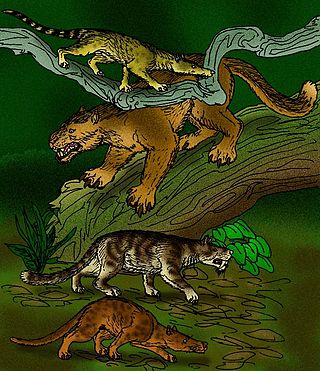
Creodonta is a former order of extinct carnivorous placental mammals that lived from the early Paleocene to the late Miocene epochs in North America, Europe, Asia and Africa. Originally thought to be a single group of animals ancestral to the modern Carnivora, this order is now usually considered a polyphyletic assemblage of two different groups, the oxyaenids and the hyaenodontids, not a natural group. Oxyaenids are first known from the Palaeocene of North America, while hyaenodonts hail from the Palaeocene of Africa.
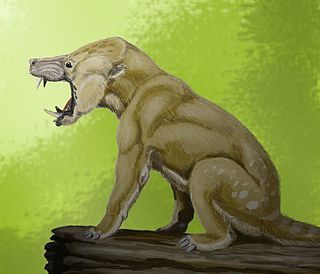
Condylarthra is an informal group – previously considered an order – of extinct placental mammals, known primarily from the Paleocene and Eocene epochs. They are considered early, primitive ungulates. It is now largely considered to be a wastebasket taxon, having served as a dumping ground for classifying ungulates which had not been clearly established as part of either Perissodactyla or Artiodactyla, being composed thus of several unrelated lineages.

Mesonychia is an extinct taxon of small- to large-sized carnivorous ungulates related to artiodactyls. Mesonychians first appeared in the early Paleocene, went into a sharp decline at the end of the Eocene, and died out entirely when the last genus, Mongolestes, became extinct in the early Oligocene. In Asia, the record of their history suggests they grew gradually larger and more predatory over time, then shifted to scavenging and bone-crushing lifestyles before the group became extinct.

South American native ungulates, commonly abbreviated as SANUs, are extinct ungulate-like mammals that were indigenous to South America from the Paleocene until the end of the Late Pleistocene. They represented a dominant element of South America's Cenozoic terrestrial mammal fauna prior to the arrival of living unguate groups in South America during the Pliocene and Pleistocene as part of the Great American Interchange. They comprise five major groups conventionally ranked as orders—Astrapotheria, Litopterna, Notoungulata, Pyrotheria, and Xenungulata—as well as the primitive "condylarth" groups Didolodontidae and Kollpaniinae. It has been proposed that some or all of the members of this group form a clade, named Meridiungulata, though the relationships of South American ungulates remain largely unresolved. The two largest groups of South American ungulates, the notoungulates and the litopterns, were the only groups to persist beyond the mid Miocene. Only a few species of notoungulates and litopterns survived until the end-Pleistocene extinction event around 12,000 years ago where they became extinct with most other large mammals in the Americas, shortly after the first arrival of humans into the region.

Arctocyon is an extinct genus of ungulate mammals. Arctocyon was a "ground dwelling omnivore", that lived from 61.3-56.8 Ma. Synonyms of Arctocyon include Claenodon, and Neoclaenodon. Arctocyon was likely plantigrade, meaning that it walked with its feet flat on the ground, rather than on its toes.

Protungulatum is an extinct genus of eutherian mammals within extinct family Protungulatidae, and is possibly one of the earliest known placental mammals in the fossil record, that lived in North America from the Late Cretaceous to early Paleocene.

Ferungulata is a grandorder of placental mammals that groups together mirorder Ferae and clade Pan-Euungulata. It has existed in two guises, a traditional one based on morphological analysis and a revised one taking into account more recent molecular analyses. The Fereungulata is a sister group to the order Chiroptera (bats) and together they make clade Scrotifera.
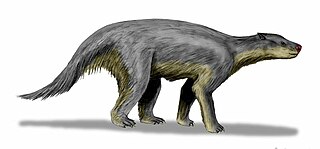
Pantodonta is an extinct suborder of eutherian mammals. These herbivorous mammals were one of the first groups of large mammals to evolve after the end of the Cretaceous. The last pantodonts died out at the end of the Eocene.

Mesonychidae is an extinct family of small to large-sized omnivorous-carnivorous mammals. They were endemic to North America and Eurasia during the Early Paleocene to the Early Oligocene, and were the earliest group of large carnivorous mammals in Asia. Once considered a sister-taxon to artiodactyls, recent evidence now suggests no close connection to any living mammal. Mesonychid taxonomy has long been disputed and they have captured popular imagination as "wolves on hooves", animals that combine features of both ungulates and carnivores. Skulls and teeth have similar features to early whales, and the family was long thought to be the ancestors of cetaceans. Recent fossil discoveries have overturned this idea; the consensus is that whales are highly derived artiodactyls. Some researchers now consider the family a sister group either to whales or to artiodactyls, close relatives rather than direct ancestors. Other studies define Mesonychia as basal to all ungulates, occupying a position between Perissodactyla and Ferae. In this case, the resemblances to early whales would be due to convergent evolution among ungulate-like herbivores that developed adaptations related to hunting or eating meat.

Arctocyonidae is as an extinct family of unspecialized, primitive mammals with more than 20 genera. Animals assigned to this family were most abundant during the Paleocene, but extant from the late Cretaceous to the early Eocene . Like most early mammals, their actual relationships are very difficult to resolve. No Paleocene fossil has been unambiguously assigned to any living order of placental mammals, and many genera resemble each other: generalized robust, not very agile animals with long tails and all-purpose chewing teeth, living in warm closed-canopy forests with many niches left vacant by the K-T extinction.
The Clarkforkian North American Stage, on the geologic timescale, is the North American faunal stage according to the North American Land Mammal Ages chronology (NALMA), typically set from 56,800,000 to 55,400,000 years BP lasting 1.4 million years.
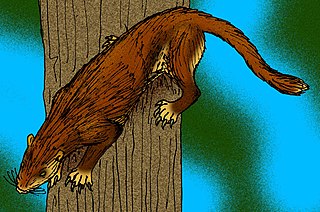
Hyopsodontidae is an extinct family of primitive mammals, initially assigned to the order Condylarthra, living from the Paleocene to the Eocene in North America and Eurasia. Condylarthra is now thought to be a wastebasket taxon; hyopsodontids have occasionally been speculated to be related to Afrotheria, but the most recent consensus is that they are related to Perissodactyla. Analysis of the inner ear shows shared characteristics with the Equoidea ; they may be a basal ungulate group near to perissodactyls.

Phenacodontidae is an extinct family of large herbivorous mammals traditionally placed in the “wastebasket taxon” Condylarthra, which may instead represent early-stage perissodactyls. They lived from the late early Paleocene to early middle Eocene and their fossil remains have been found in North America and Europe. The only unequivocal Asian phenacodontid is Lophocion asiaticus.

Triisodon is a genus of extinct mesonychian mammal that existed during the Early Paleocene of New Mexico, North America, from about 63.5-62.0 Ma. The genus was named by Edward Drinker Cope in 1881 as a member of the Acreodi, a now invalid taxon that encompassed creodonts, mesonychians and certain arctocyonians. Cope described the type specimen of T. quivirensis as "about the size of a wolf." A smaller species, T. crassicuspis, has also been identified from the same region. Since material from this genus is incomplete, the exact size of adults and whether they showed sexual dimorphism or regional variations in size is unknown.

Palaeonictis is an extinct genus of placental mammals from extinct subfamily Palaeonictinae within extinct family Oxyaenidae, that lived in Europe and North America from the late Paleocene to the early Eocene.
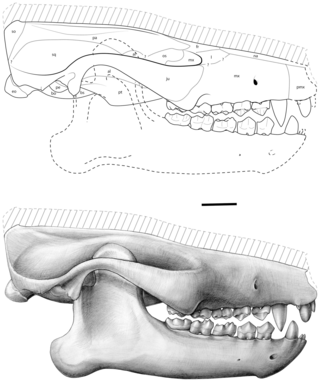
Ocepeia is an extinct genus of afrotherian mammal that lived in present-day Morocco during the middle Paleocene epoch, approximately 60 million years ago. First named and described in 2001, the type species is O. daouiensis from the Selandian stage of Morocco's Ouled Abdoun Basin. A second, larger species, O. grandis, is known from the Thanetian, a slightly younger stage in the same area. In life, the two species are estimated to have weighed about 3.5 kg (7.7 lb) and 10 kg (22 lb), respectively, and are believed to have been specialized leaf-eaters. The fossil skulls of Ocepeia are the oldest known afrotherian skulls, and the best-known of any Paleocene mammal in Africa.

Hyaenodonta is an extinct order of hypercarnivorous placental mammals of clade Pan-Carnivora from mirorder Ferae. Hyaenodonts were important mammalian predators that arose during the early Paleocene in Europe and persisted well into the late Miocene.
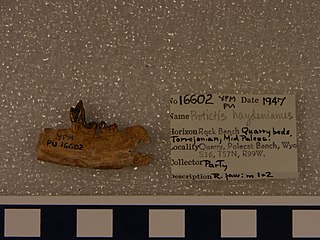
Protictis is an extinct paraphyletic genus of placental mammals from extinct subfamily Didymictinae within extinct family Viverravidae, that lived in North America from early Paleocene to middle Eocene.
















